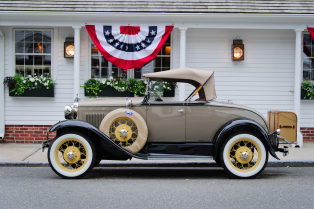Fog. I knew before I opened my eyes. The peculiar quiet told me.
Sitting up from under warm covers I stretched in the darkness. The air was quiet in that way that fog brings to the coast, muffling the distant thunder of breaking waves. Squirrel steps on the roof melting like smoke in a breeze.
A brief drive through the village to the waterfront, then a serpentine walk between boats in cradles, shuttered sheds, racked masts, overgrown keels, sloops, a schooner, skiffs and nets. Then the rocking motion of the dock floats under my feet. The dense fog brushed my face like bed sheets on a clothesline. The closer to the water’s edge I walked, the heavier the air became, and the quieter the harbor became. Visibility decreased to near zero.
Perfect.
I slowed as I neared the end of the dock. I had walked this way countless times and been surprised often enough by untethered floats or the presence of sea birds hidden in the fog, startled by my intrusion on their perch. Finally, I glimpsed the ghostlike silhouette of the last section and the piling to which it was anchored. With legs spread and feet planted securely on the slick planks, I raised my camera and peered north.
My goal was to catch a glimpse of what North Cove’s waterbirds did when they were invisible. The cove and much of the sound beyond were shrouded in a heavy fog. Most villagers had remained indoors. It was early, the fog would take time to lift, and another cup of hot coffee was preferable to the damp conditions on the water. Songbirds were silent, waiting in the boughs for sunlight. In this interval of blindness, what did the land and water birds do in the absence of we humans? Did they know that we were blinded, too?
Sailors were uninterested in venturing out in this heavy soup air, so there were no wakes from passing boats to destabilize my floating patch of wood. A large white swan materialized out of nowhere and glided silently by, taking note of me briefly as she passed.
As I waited, I thought about the mystery of different lives – the birds and us – living on the shore in parallel existences. Do we live the same reality, or do we experience this foggy morning differently, from different perspectives? One hundred seventy years ago, Schopenhauer observed that man takes the limits of his field of vision for the boundaries of the world. It would be reasonable to think that the birds’ perspective of their world this morning was narrowed by the fog, too.
This thought is what motivated me out of my warm bed and into the sodden fog reaches of the harbor to stand and wait silently for the sun to evaporate the fog. Part of me wondered if the birds’ existence expanded in man’s absence for a few hours of freedom from our intrusion into their world. Were their lives better in our absence? Or just different? My hoped-for insight into their behavior during those fleeting moments as the veil lifted was coming. I could see two lengths of dock sections -- about forty feet. It wouldn’t be long now.
My targets were the floats and mooring lines about eight hundred feet from my perch on the northernmost dock in the harbor. Gradually, as the fog loosened its grip on me and the middle distance of open water, faint outlines emerged. First the floats, then two large dark silhouettes perched on spring rods, which themselves were not yet discernible. Then the pilings and the sign on one that read “NO WAKE.” Then a green heron and two black-crowned herons standing stoically in the gloom came into view. An osprey glided into the scene and displaced one of the silhouettes. A few alert gulls shifted their stance, waiting like commuters on a train platform. An egret stood still as white marble on the third and last float. They were all quiet in the morning stillness, competitors apparently content to wait as a group for daylight. I shot selectively, bracketed and captured multiples of each setting to compensate for the rising bird activity as the scene brightened. My camera’s shutter was muted, yet its sound surely carried across the water to their alert senses.
Several dozen exposures and 20 minutes later, I had captured a few images that glimpse the ephemeral nature of wildlife in retreating fog. Months later, one of those images won the Lyme Land Trust Juried Photo Contest.
_______________________
View my Shoreline Collection and please stop by my Gallery Shop to consider a special series of signed and numbered limited-edition prints for the collector. A miniature print of a tall ship would make a wonderful gift for yourself or a thoughtful surprise for a friend.




